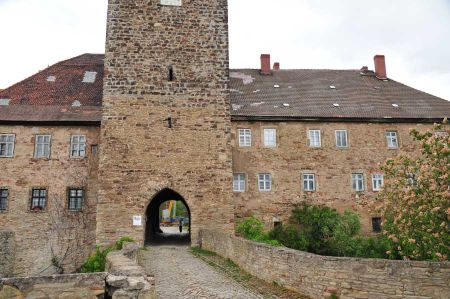Castle and imperial palace in the small town of Allstedt
- Written by Portal Editor
We were on our way back from Sangerhausen when, after about 12 kilometers, we came across the town of Allstedt, which is overlooked by a magnificent castle complex.
Of course, our interest aroused immediately and once again we went on a local excursion. The castle complex is located about 800 m northeast of the old town on a spur protruding to the west from the plateau. Remnants of moats and groups of buildings divide the castle complex into three parts one behind the other, which cannot be seen from a distance. We parked the vehicle a little off the beaten track on a large green area not far from the access road to the castle and noticed as soon as we approached that the complex was showing more castle-like modifications and additions, so the names are quite different. Our interest grew.
First internet research on the Memorial to the Fallen
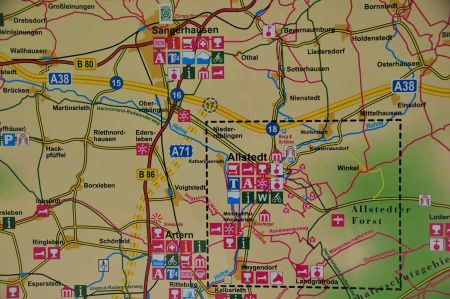 Of course, we wanted to find out some details about the castle first, so we paused at a memorial to the war victims across from the driveway. During our first research, we already learned that during archaeological excavations on the Schlossberg in the 1960s, the State Museum of Prehistory in Halle cut the upper part of a 12 m wide ditch that separates the Schlossberg from the plateau. Due to its assumed shape as a pointed moat, it is said to have been dug in the Ottonian period at the latest, according to the chief archaeologist Bertold Schmidt. For that, the already documented royal palatinate is located at the site of the castle, while in the eastern part of the present-day location a farmyard is assumed. The Palatinate Allstedt was a royal palace of the Ottonians. Allstedt Castle now houses a museum on the history of the Palatinate, castle and town of Allstedt as well as an indoor castle café. The facility is a station on the Romanesque Road. Unfortunately closed at the time of our visit.
Of course, we wanted to find out some details about the castle first, so we paused at a memorial to the war victims across from the driveway. During our first research, we already learned that during archaeological excavations on the Schlossberg in the 1960s, the State Museum of Prehistory in Halle cut the upper part of a 12 m wide ditch that separates the Schlossberg from the plateau. Due to its assumed shape as a pointed moat, it is said to have been dug in the Ottonian period at the latest, according to the chief archaeologist Bertold Schmidt. For that, the already documented royal palatinate is located at the site of the castle, while in the eastern part of the present-day location a farmyard is assumed. The Palatinate Allstedt was a royal palace of the Ottonians. Allstedt Castle now houses a museum on the history of the Palatinate, castle and town of Allstedt as well as an indoor castle café. The facility is a station on the Romanesque Road. Unfortunately closed at the time of our visit.
King Heinrich I issues a certificate for Altstedi
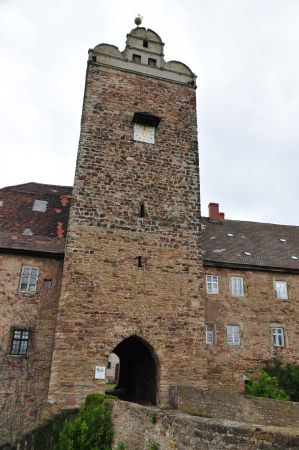 The place Allstedt was first mentioned in the year 777 in the Breviarium Sancti Lulli. The castle is mentioned as urbs Altstediburg for the first time in the Hersfeld tithe directory that was created between 880 and 899. The list includes several castles and a large number of settlements in Friesenfeld and Hassegau, including Alstedi, the tithe of which is paid to the Hersfeld monastery.
The place Allstedt was first mentioned in the year 777 in the Breviarium Sancti Lulli. The castle is mentioned as urbs Altstediburg for the first time in the Hersfeld tithe directory that was created between 880 and 899. The list includes several castles and a large number of settlements in Friesenfeld and Hassegau, including Alstedi, the tithe of which is paid to the Hersfeld monastery.
Almost all German kings and emperors were guests here from 935 to 1200. In the 10th century, the imperial property came to the new ruling family of the Ottonians, who also owned numerous property in the area between the Harz, Saale and Unstrut. On October 12, 935, King Heinrich I issued a certificate in Altstéti in which he granted the women of Herford Abbey the right to vote.
Before or at the beginning of 979, Emperor Otto II and his wife Theophanu had donated the Benedictine monastery Memleben on the Unstrut, about 20 kilometers south of Allstedt. On May 20, 979 Otto had a certificate issued in Altstedi in which he signed over the monastery and the chapels in the towns of Allstedt, Osterhausen and Riestedt that had previously belonged to the Hersfeld monastery and had been acquired by him in exchange. In addition, Memleben received the tithe in Friesenfeld and Hassegau, especially the castles there, among which the Alstediburch is mentioned first.
Imperial assemblies, diets and the documents sealed on site from the 10th to 12th centuries bear witness to the political importance of the empire. In the Sachsenspiegel of Eike von Repkow, the most important German-language legal book of the Middle Ages, the Palatinate Allstedt was listed among the five most important in Saxony at that time.
Reconstruction of the castle complex from the 13th century
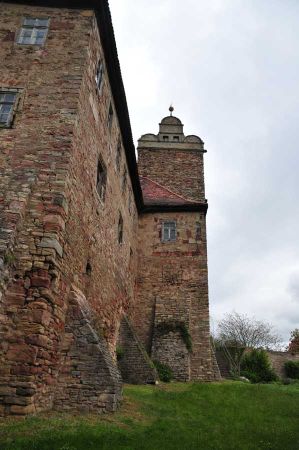 The oldest structure that has survived today dates from the middle of the 13th century. The oldest visible part of the castle, the residential tower to the right of the entrance, dates from around 1400.
The oldest structure that has survived today dates from the middle of the 13th century. The oldest visible part of the castle, the residential tower to the right of the entrance, dates from around 1400.
The noble lords of Querfurt, to whom the castle belonged from 1369 to 1496, had the old Allstedt Castle demolished and several structural changes carried out, including the north wing, the west wing with the hall, kitchen and large courtyard, the shield wall in the south and the shield wall in the east Build gate system. This was roughly the size of today's castle.
In 1691, under the Dukes of Saxony, there was another structural change to the upper floor, and the remaining parts of the core castle were converted into a residential palace. In 1721 the castle chapel was built in its present form.
Ernst August I of Saxe-Weimar-Eisenach had the front castle built in the Baroque style in 1746/1747. But he could no longer implement his plans († 1748). The reconstruction of the front castle was just implemented in a simple form, and the core castle was retained in its original form.
Privatization and today use
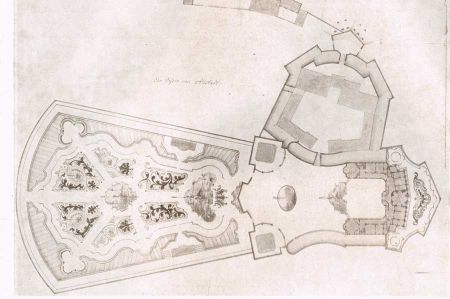 In the course of the renovation work, Reinhard Schmitt was able to carry out structural historical investigations between 1986 and 1991. At the end of 2017, the Allstedt town council sold the front part of the castle and palace complex, known as the outer bailey, with the south palace building parts (east and west wings framed by the gate tower), parts of the moat in front of the east wing, plus two cavalier houses and adjoining stables to a private investor for € 79,000. Since then, the facility has been privately managed and is home to a marketing agency and a publishing house. In further steps, the outer bailey will be expanded with a small hotel and gastronomic facility (opening of a beer garden in 2019). A cooperation with the city administration and the museum in the core of the complex has been promoting the development since 2019, among other things by various events.
In the course of the renovation work, Reinhard Schmitt was able to carry out structural historical investigations between 1986 and 1991. At the end of 2017, the Allstedt town council sold the front part of the castle and palace complex, known as the outer bailey, with the south palace building parts (east and west wings framed by the gate tower), parts of the moat in front of the east wing, plus two cavalier houses and adjoining stables to a private investor for € 79,000. Since then, the facility has been privately managed and is home to a marketing agency and a publishing house. In further steps, the outer bailey will be expanded with a small hotel and gastronomic facility (opening of a beer garden in 2019). A cooperation with the city administration and the museum in the core of the complex has been promoting the development since 2019, among other things by various events.
Please read as well:
The bike path along the Unstrut - Memleben monastery
Unstrut cycle path - from Roßleben to Memleben
-
 Kaiserpfalz and Castle of Allstedt
Kaiserpfalz and Castle of Allstedt
Kaiserpfalz and Castle of Allstedt
Kaiserpfalz and Castle of Allstedt
-
 Kaiserpfalz and Castle of Allstedt
Kaiserpfalz and Castle of Allstedt
Kaiserpfalz and Castle of Allstedt
Kaiserpfalz and Castle of Allstedt
-
 Kaiserpfalz and Castle of Allstedt
Kaiserpfalz and Castle of Allstedt
Kaiserpfalz and Castle of Allstedt
Kaiserpfalz and Castle of Allstedt
-
 Kaiserpfalz and Castle of Allstedt
Kaiserpfalz and Castle of Allstedt
Kaiserpfalz and Castle of Allstedt
Kaiserpfalz and Castle of Allstedt
-
 Kaiserpfalz and Castle of Allstedt
Kaiserpfalz and Castle of Allstedt
Kaiserpfalz and Castle of Allstedt
Kaiserpfalz and Castle of Allstedt
-
 Kaiserpfalz and Castle of Allstedt
Kaiserpfalz and Castle of Allstedt
Kaiserpfalz and Castle of Allstedt
Kaiserpfalz and Castle of Allstedt
-
 Kaiserpfalz and Castle of Allstedt
Kaiserpfalz and Castle of Allstedt
Kaiserpfalz and Castle of Allstedt
Kaiserpfalz and Castle of Allstedt
-
 Kaiserpfalz and Castle of Allstedt
Kaiserpfalz and Castle of Allstedt
Kaiserpfalz and Castle of Allstedt
Kaiserpfalz and Castle of Allstedt
-
 Kaiserpfalz and Castle of Allstedt
Kaiserpfalz and Castle of Allstedt
Kaiserpfalz and Castle of Allstedt
Kaiserpfalz and Castle of Allstedt
-
 Kaiserpfalz and Castle of Allstedt
Kaiserpfalz and Castle of Allstedt
Kaiserpfalz and Castle of Allstedt
Kaiserpfalz and Castle of Allstedt
-
 Kaiserpfalz and Castle of Allstedt
Kaiserpfalz and Castle of Allstedt
Kaiserpfalz and Castle of Allstedt
Kaiserpfalz and Castle of Allstedt
-
 Kaiserpfalz and Castle of Allstedt
Kaiserpfalz and Castle of Allstedt
Kaiserpfalz and Castle of Allstedt
Kaiserpfalz and Castle of Allstedt
https://www.alaturka.info/en/germany/saxony-anhalt/5428-castle-and-imperial-palace-in-the-small-town-of-allstedt#sigProId55ce0c84fa
